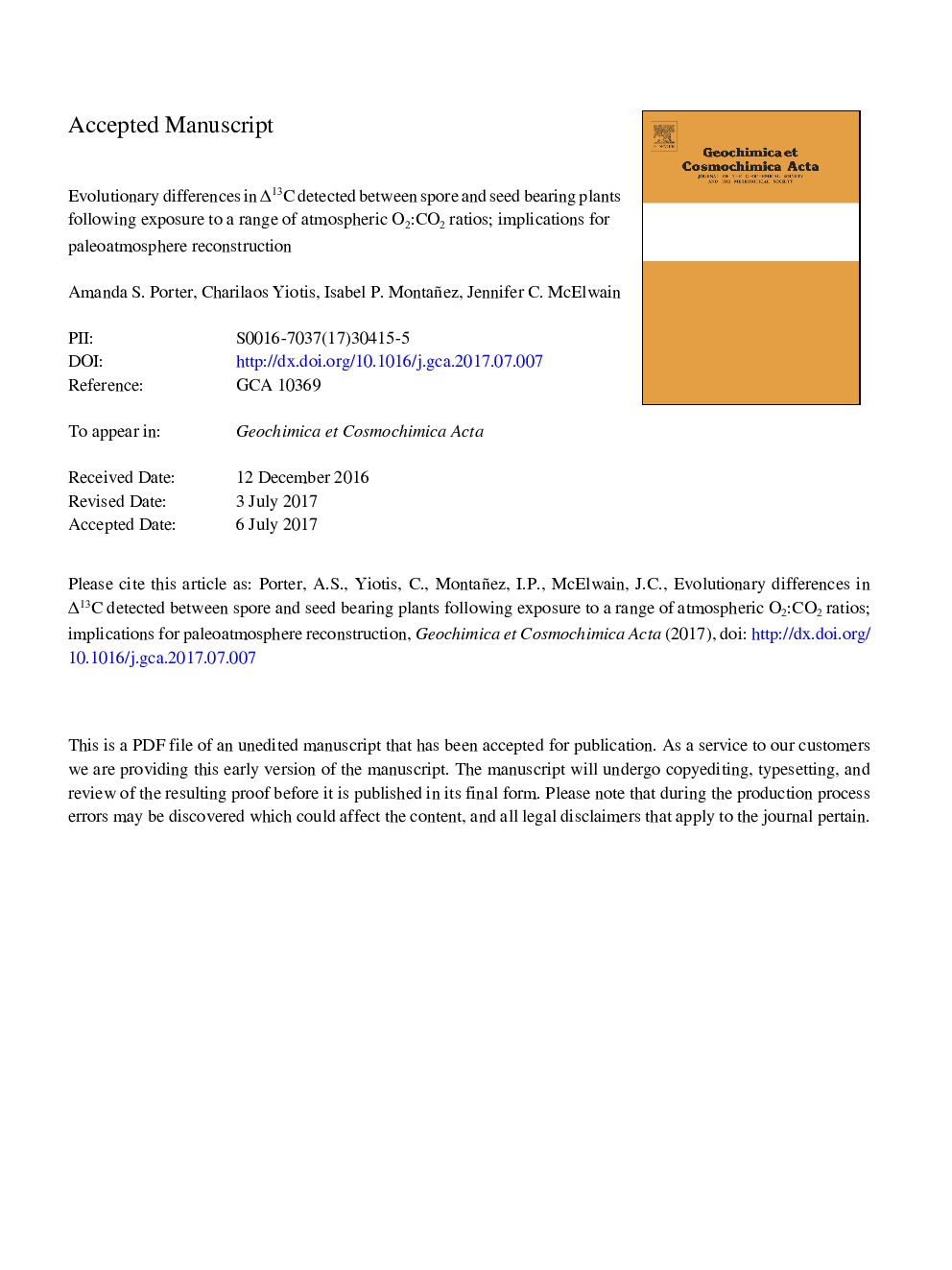| کد مقاله | کد نشریه | سال انتشار | مقاله انگلیسی | نسخه تمام متن |
|---|---|---|---|---|
| 5783346 | 1637944 | 2017 | 45 صفحه PDF | دانلود رایگان |
عنوان انگلیسی مقاله ISI
Evolutionary differences in Î13C detected between spore and seed bearing plants following exposure to a range of atmospheric O2:CO2 ratios; implications for paleoatmosphere reconstruction
دانلود مقاله + سفارش ترجمه
دانلود مقاله ISI انگلیسی
رایگان برای ایرانیان
موضوعات مرتبط
مهندسی و علوم پایه
علوم زمین و سیارات
ژئوشیمی و پترولوژی
پیش نمایش صفحه اول مقاله

چکیده انگلیسی
The stable carbon isotopes of fossil plants are a reflection of the atmosphere and environment in which they grew. Fossil plant remains have thus stored information about the isotopic composition and concentration of atmospheric carbon dioxide (pCO2) and possibly pO2 through time. Studies to date, utilizing extant plants, have linked changes in plant stable carbon isotopes (δ13Cp) or carbon isotope discrimination (Î13C) to changes in pCO2 and/or pO2. These studies have relied heavily on angiosperm representatives, a phylogenetic group only present in the fossil record post-Early Cretaceous (â¼140 million years ago (mya)), whereas gymnosperms, monilophytes and lycophytes dominated terrestrial ecosystems prior to this time. The aim of this study was to expand our understanding of carbon isotope discrimination in all vascular plant groups of C3 plants including lycophytes, monilophytes, gymnosperms and angiosperms, under elevated CO2 and sub-ambient O2 to explore their utility as paleo-atmospheric proxies. To achieve this goal, plants were grown in controlled environment chambers under a range of O2:CO2 ratio treatments. Results reveal a strong phylogenetic dependency on Î13C, where spore-bearing (lycophytes and monilophytes) have significantly higher 13C discrimination than seed plants (gymnosperms and angiosperms) by â¼5â°. We attribute this strong phylogenetic signal to differences in Ci/Ca likely mediated by fundamental differences in how spore and seed bearing plants control stomatal aperture. Decreasing O2:CO2 ratio in general resulted in increased carbon isotope discrimination in all plant groups. Notably, while all plant groups respond unidirectionally to elevated atmospheric CO2 (1900 ppm and ambient O2), they do not respond equally to sub-ambient O2 (16%). We conclude that (1) Î13C has a strong phylogenetic or 'reproductive grade' bias, whereby Î13C of spore reproducing plants is significantly different to seed reproducing taxa. (2) Î13C increases with decreasing O2:CO2 ratios (where significant) but is more likely a result of mechanistically uncoupled responses to elevated pCO2 and sub-ambient O2; and (3) due to this response we find δ13Ca cannot be calculated from δ13Cp unless environmental influences such as O2:CO2 ratio can be independently constrained. Therefore, interpretations of trends in fossil plant δ13Cp to reconstruct paleoatmospheric CO2 concentration should include cross calibration based on a nearest living relative, appropriate nearest living equivalent, or utilizing the phylogenetic corrections produced from this study.
ناشر
Database: Elsevier - ScienceDirect (ساینس دایرکت)
Journal: Geochimica et Cosmochimica Acta - Volume 213, 15 September 2017, Pages 517-533
Journal: Geochimica et Cosmochimica Acta - Volume 213, 15 September 2017, Pages 517-533
نویسندگان
Amanda S. Porter, Charilaos Yiotis, Isabel P. Montañez, Jennifer C. McElwain,